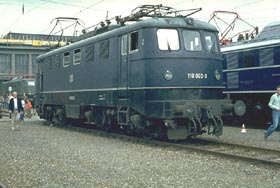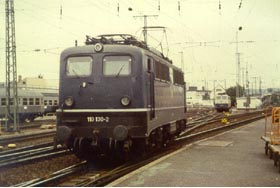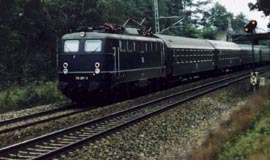E 10.0/E10.1
Introduction
E 10 001
E 10 002
E 10 003
E 10 004 and E 10 005
Delivery
Constructie
Introduction
From 1952 the DB was working on a new program for electric locomotives. Because of the on going electrying of main lines, there was need for new electric locomotives. These new built locomotives had to replace the old pre war DRG electric locomotives.
The developments began in 1948. The DB started to work out old plans originated from the DRG to develop a universal locomotive of class E 46. This new locomotives of class E 46 was meant for fast express trains with speeds of 120 km/h and medium heavy freight trains. After the locomotive industry had presented a couple of drawings to the DB, the DB changed their plans and the new locomotives must have a top speed of 130 km/h. The indication of the locomotive was also changed to E 10.
Begin fifties the DB ordered four prototype locomotives of class E 10, the four locomotives were numbered as E 10 001 upto 004. The four locomotives were equiped with different motors and transmissions to test and compare the different driving concepts. At the end of 1950 the DB orderded a fifth locomotive, the E 10 005.
With the experencies done with the five prototype locomotives E 10 001 upto 005, the BZA München setup a big planning and time plan for building new electric locomotives.
In this planning the locomotive for express trains was indicated as E 10.1. You can distinguish three different series of E 10 locomotives (in epoch IV BR 110) built during the years. Each locomotive has it's own chapter on this website. The first series of locomotives were the five prototypes and the mass produced locomotives of class E 10.1. The second series were the so-called Bügelfalte locomotives of class E 10.3, and the third series were the Rheingold/TEE locomotives E 10.12-13.
E 10 001
In August 1952 Krauss-Maffei (body parts) and AEG (electrical parts) deliver the first prototype for the new multi functional electric locomotive. The locomotive E 10 001 was put into service from the Bw München. At the beginning of 1955, after extensive tests, the locomotive went to the Bw Nürnberg Hbf. From that moment the locomotive was tested in the regular services in express trains to München, Regensburg and Würzburg. And from 1958 also in services to Passau and Frankfurt/M.
The locomotive had four powered axles which were driven by an Alsthom transmission. The electricity which fed the motors was conducted by a system with a switch with 18 positions.
From the mid seventies the locomotive was only in service in eilzüge and low graded passenger trains to Bamberg, Coburg and Treuchtlingen. The maintenance of this locomotive was expensive because he uniqueness of the parts. So the E 10 001 was the first E 10 locomotive which was set aside in 1975.
E 10 002
In December 1953 the second prototype was entering service, the E 10 002. This locomotive was built by Krupp (body parts) and BBC (electrical parts) and was stationed in the Bw München Hbf.
 | | E 10 002 in AW München Freimann, October 1977 | Photo: Christian Splittgerber |
All four axles were powered by means of a cardan shaft. The electric motors were from BBC. The current was fed to the motors by a switch with 28 positions.
In every day practice, the E 10 002 had many failures, because of that, BBC replaced in the summer of 1955 all four motors by other motors. Due to the many failures of the locomotive this locomotive was only half the time in service in comparison with the other prototype locomotives. In May 1955 this locomotive went to the Bw Nürnberg Hbf and went in service together with the other prototype locomotives in the regular express train services. Because of the high maintenance costs of this single locomotive it was set aside in Oktober 1977. The locomotive is preserved as a museum locomotive and is standing since December 1984 in the trafficmuseum of Nürnberg.
E 10 003
In December 1952 Henschel (body parts) and Siemens (electrical parts) delivered the third E 10 prototype. The locomotive was stationed in the Bw Nürnberg as E 10 003. This locomotive was provided with a so-called called "tram-hanging" inside the bogies, where the traction motors were hanging. The four axles were powered by a so called "Gummiringantrieb" which was developed by Siemens. This transmission was already proven in the E 44 038. The principal is that the traction motors are hanging in a sort of rubbers inside the bogies. It appeared that the transmission was very suitable for the E 10, and was later made the standard transmission for locomotives which were produced in mass production. The tension of the current was adjustable in 33 steps.
This locomotive was also subject to an extensive testing program and made testruns on the Alberg railwayline in Austria. For the services in the regular express trains the locomotive went to the Bw München Hbf in November 1953 and went next in April 1954 to the Bw Nürnberg Hbf.
From the mid sixties, the locomotive was mainly found in eilzüge and local train services. After incurred some damage in 1960 there were some troubles with the parts delivery, but in January 1966 the locomotive was again in service. The locomotive was set aside in 1976.
E 10 004 and E 10 005
The fourth and fifth prototype had the same looks as the E 10 003. Both locomotives were built by Henschel, AEG and BBC delivered together the electric components for the two locomotives. The E 10 004 was delivered in December 1952 and the E 10 005 in March 1953 to the Bw München Hbf. The E 10 004 was subject to extensive tests like the other prototype locomotives. On the other hand the E 10 005 went in July 1953 to the Bw Nürnberg Hbf and was immediately entering the regular services. The E 10 004 came in October 1954 to Nürnberg.
Both locomotives were powered by an Alsthom transmission which was derived of the transmission of the E 10 001. The current for the traction motors was adjustable in 28 steps. Later this current switch was the standard switch in the locomotives of class E 41. Like the other prototype locomotives it was not anymore economical to maintain the locomotives in the seventies because the shortages and uniqueness parts for the five prototype locomotives. Because of that the E 10 004 was set aside in January 1977 (as 110 004) and the E 10 005 was set aside in August 1977 (as 110 005). Both locomotives were preserved as museum locomotives and are standing now in the Bayerischen Eisenbahn Museum in Nördlingen.
Delivery
The E 10 was developed by Krauss-Maffei and Siemens. Also Krupp, Henschel, AEG and BBC contributed to the production of the E 10 locomotives. Between the start of the planning and developments in 1949 and the delivery of the first new electric locomotives in 1956 were only 7 years. This is for present notions a very short time. In this short time they carried out many preperations and tests.
 | | Locomotive E 10 130, on the first generation E 10 locomotives | Photo: Alex Strueder |
In October 1954 the first 31 locomotives class E 10 were ordered by the DB, the E 10 101 -131. The first locomotive, the E 10 10.1 was delivered on 4 December 1956. The locomotives had their services in the high graded long-distance trains on the new electrified mainlines. These locomotives were also indicated as E 10.1.
Until 1963 the following locomotives were built and delivered: E 10 102- 264 and E 10 271 - 278. The locomotives between these two series were the first Rheingold locomotives with the more aerodynamic fronts, the E 10 1265 - 1270, see also the E 10.12-13. From locomotive E 10 288 all E 10 locomotives had these aerodynamic fronts, these locomotives were also called the "Bügelfalte" locomotives, these are of class E 10.3.
The E 10 locomotives set new criteria for the construction of electrical locomotives. A characteristic of these new locomotives was the fact that they had a high power in comparison with a relative low weight. The small vulnerability and the big maintenance intervals, as well as the user friendly controls were all characteristics of these locomotives.
With these marks the locomotives had more advantages than it's predecessors. The experenciences done with these locomotives were used in the development of the express train locomotive BR 111 and the freight locomotive BR 151 in epoch IV. In these locomotives you can find lot's of parts also used in the E 10 locomotives (BR 110).
From 1968 all locomotives E 10 were renumbered to class 110.
Constructie
 | | E 10 281 with double front and rear signals | Photo: H.H.U. Konijnendijk |
The locomotives exist of four main parts. The locomotive upper construction, the chassis or frame and the two bogies. The four parts were all of a welded construction. Until locomotive E 10 215 the front and rear lamps were assembled together in one lamphouse on the fronts. From E 10 216 the locomotives had two lamps above each other. One front lamp, and one rear lamp. Also other air grids were used from locomotive E 10 216. In the eigthies all air grids from all locomotives were replaced by air grids which were more maintenance friendly. At the beginning of the eighties the DB removed also the skirts around the buffers, the rods were replaced by more simple ones and the silver colored roof was abandoned, like the raingutters.
All locomotives E 10.1 were provided with Siemens "Gummifederantrieb", to switch the tension to the driving motors they made use of a switch with 28 positions. The locomotives were equiped with pantographs of type DBS 54 with double trails.
With the foundation of the DB they declared that all electrical locomotives which had a maximum speed lower than 120 km/h, got a green coloring (RAL 6007), all locomotives with speeds above 120 km/h must painted in a blue color (RAL 5011). This blue livery was the same as the first class coaches which operated in the F-train network. Because of that all locomotives E 10.0 and E 10.1 got the blue livery (RAL 5011). The locomotives had on both sides the DB logo, the fronts had no DB logo.
| Axle layout |
Bo'Bo' |
| In service: |
1956-1963 |
| Diameter driving wheels: |
125 cm |
| Length: |
16,49 m |
| Top speed: |
150 km/h |
| Power: |
3700 kW at 105 km/h |
| Number of motors: |
4 |
| Torque: |
275 kN |
| Tension: |
15 kV ~/16 2/3 Hz |
| Weight: |
84,6 t |
|
